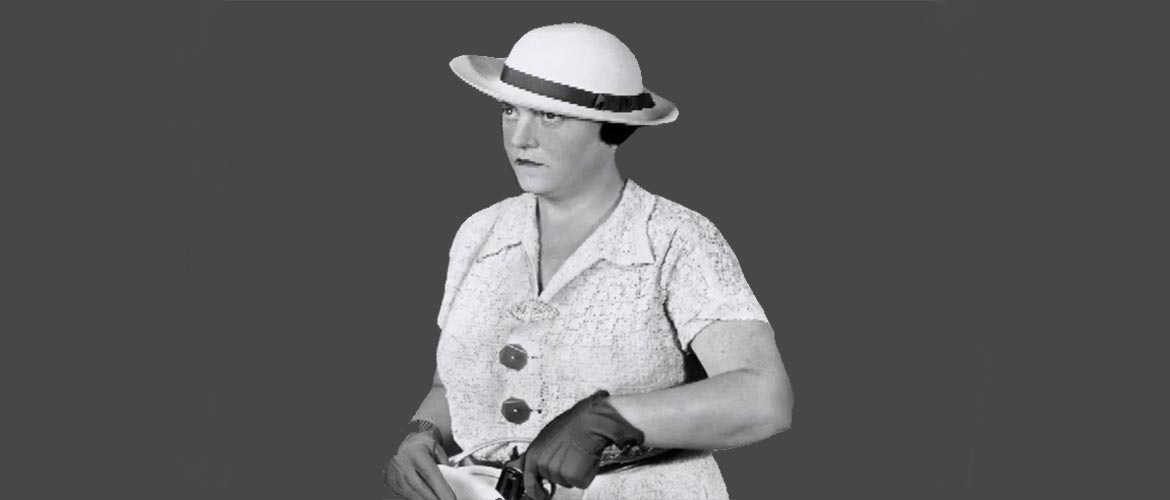No time to read? Listen to the podcast.
Irving Berlin missed it by a mile. And Ethel Merman piped up with the same mistake. You can’t get a man with a gun? Hah. Tell that to Mary Shanley.
Shanley got over 1,000 men with a gun. And some of them were women.
Shanley, the fourth policewoman in New York City elevated to the rank of detective first-grade, “was the first policewoman in the history of the NYPD to use a gun during a capture and arrest, when she fired into the air while pursuing a racketeer on 53rd Street,” reported Atlas Obscura.
It earned her the nickname Dead Shot Mary.
Shanley was outspoken and opinionated, a woman who would have been quite at home today but didn’t fit in in her time.
Shanley’s specialty was bringing down pickpockets, seat-tippers and con men (and women). Most of them, like Princess Juniata Flynn, went peacefully.
Flynn was a fortune teller whose paranormal gifts included a concealed telephone handset underneath her bandana and a basket with a false bottom into which victims dropped questions they wanted answered.
But for those for whom being arrested by a woman wasn’t exciting enough, there was always that nickname.
Once, Shanley tailed two pickpockets crosstown, from Grand Central Station to Pennsylvania Station, watching as they plied their trade. She arrested them in their getaway car as they were about to speed away.
When the duo didn’t believe Shanley was serious about their stepping out of their vehicle, she pulled her service revolver and offered them another option—having their heads blown off.
The pickpockets had a change of heart, but couldn’t stop complaining about the ignominy of being arrested “by a dame.”
Even the rather staid New York Times doled out extra helpings of verbs and adjectives when describing Shanley’s exploits. Reporting Shanley’s arrest of “two suspicous characters, neither of them weaklings,“ the Times wrote about the pair, “They complied, for everything in the policewoman’s mein indicated determination—even the firm grasp of her right hand on her service pistol.”
By all accounts, Shanley loved her job. In Sleuthing Mary Shanley, a documentary written and produced by Shanley’s grandnephew, Patrick Mullins, he quotes her as saying “I’d get lonesome for my pals, the crooks, if I ever retired.”
But that was the public side of Shanley. There was the other side, the family side, that didn’t find its way into newspapers and detective magazines.
“She always wanted to be a cop,” said her niece, Mary Shanley Mullins, in the documentary. And she was right for the job. “She was tough,” Mrs. Mullins said. “She was brought up tough, without a father.”
Shanley was, according to Mrs. Mullins, outspoken and opinionated, a woman who would have been quite at home today but didn’t fit in in her time.
While women officers were not unheard of on the streets of New York it wasn’t one of the city’s common occupations. Becoming a policewoman took guts and determination.
Shanley worked as a telephone operator by day and studied for the police department exam at night, joining the force in 1931 at the age of 35. She preferred working the streets alone, although she often took Mrs. Mullins, who was 10 at the time, with her as a decoy.
“You can’t look like a cop,” Shanley said during their outings.
Mrs. Mullins was Shanley’s off-duty partner as well. To unwind from work Shanley, accompanied by the young Mrs. Mullins, would drop into a local Rockaway watering hole. There she encouraged her niece to show off her tap-dancing skills.
But when bar patrons tipped Mrs. Mullins for dancing, Shanley insisted her niece use the money to buy everyone in the joint a drink. Shanley’s sense of equanimity extended to her private life as well.
When she retired in 1957, Shanley had been recognized for her achievements by none other than New York City Mayor Fiorello LaGuardia. She had made her family proud.
And then, something changed.
She moved to Florida, sold the cemetery plot reserved for her, and cut off all ties with her relatives. No one knew why. Family members speculated she suffered from dementia.
“Or maybe she felt her life was too different from the rest of the family and so she decided to make the break,” Mrs. Mullins said.
Years later, Mrs. Mullins discovered her aunt was buried in an unmarked grave in a Farmingdale, Long Island cemetery, about half-an-hour’s drive from the bar where she had danced as a child.
Unlike Annie Oakley, Mary Shanley’s story never became the kind of legend Ethel Merman immortalized in song. But, if you sit outside a certain cemetery in Long Island, and pay close attention to what goes on, you’ll see that pickpockets and fortune tellers give the place a wide berth.
Start your Sunday with a laugh. Read the Sunday Funnies, fresh humor from The Out Of My Mind Blog. Subscribe now and you'll never miss a post.
Patrick Mullins, the producer and editor of Sleuthing Mary Shanley, lives in New York’s Hudson Valley. He worked for over 20 years in film post-production in New York and California, primarily as a music editor for feature films. In addition to Sluething Mary Shanley, he produced and edited the video documentaries From Shore to Shore: Irish Traditional Music in New York City and Bracero Stories, an award-winning film broadcast on PBS stations throughout the U.S. Mullins has an M.A. in Communication from William Paterson University and an M.A. in Cinema Studies from New York University. He has taught video production and media studies at the University of Texas El Paso, Santa Fe Community College, and Dutchess Community College.
Mind Doodle…
In 1918, the New York City Police Department added the first six policewomen to its ranks. They carried guns, handcuffs, and summonses. Each one was paid the sum of $1,200 annually which, unbelievably, was the same salary paid to policemen.

